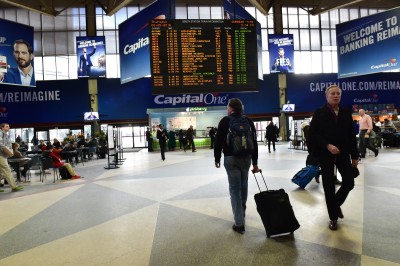
Former Massachusetts Gov. Michael Dukakis and former Massachusetts Gov. William Weld have been urging current Massachusetts Gov. Charlie Baker to move forward with a $2 million study for the North-South Rail Link, Dukakis said.
The link would consist of an underground tunnel connecting the Massachusetts Bay Transportation Authority’s South Station to the MBTA’s North Station. Dukakis said the study would last six months and provide the government with a sense of how the link could transform the city’s public transportation system and gauge the potential costs of the project.
Dukakis said the Massachusetts Department of Transportation started extensive environmental impact and preliminary engineering studies for this project under Weld’s administration. The research ended when former Massachusetts Gov. Mitt Romney took office, however, as Romney’s staff believed the link would be too expensive to complete.
Dukakis, now a political science professor at Northeastern University, said he has been interested in the construction of the North-South Rail Link since his time in office, and he believes that connecting the two stations is the only financially acceptable solution.
“The answer to this, which is now happening all over the world in at least a dozen or 15 cities and more coming, is an underground rail tunnel which connects the two stations and totally eliminates congestion,” Dukakis said. “Nobody is expanding what we call ‘stub-end stations,’ for obvious reasons. It’s expensive, it doesn’t solve the problem and so on.”
Dukakis said the benefits of establishing a rail connection between North Station and South Station would include crowd reduction in MBTA stations, additional tracks and the opportunity to foster transportation relations with other northeast cities.
“What [the link will] do, other than transforming Boston and our rail system, is make it possible for people from New York and Washington to come to Boston and go all the way to Montreal,” Dukakis said. “The bus to Montreal would be a terrific thing for both cities, and most of us in support of the North-South Rail Link think that it is a logical expansion place.”
Dukakis and Weld, along with a team of about 50 people from the local community, have been attempting to convince the Baker administration to pursue the project.
“An enormous amount of work has been done on this thing, and our hope is that we can convince the governor and the secretary to move forward on this, and the sooner the better,” Dukakis said. “There are great possibilities here, and it is time we got on with it.”
Daniel Aldrich, a professor at Northeastern University, wrote in an email that he is largely in favor of the project.
“I believe that the mile long tunnel which will connect North and South Station[s] is a great idea which will better integrate the various transportation hubs within the metropolitan area,” Aldrich wrote in the email.
Aldrich stated that connecting the rails would emphasize the importance of utilizing public transportation.
“By adding in a way for commuters to move quickly and directly between these two poles, Boston authorities will relieve congestion and help ensure that we continue to create an atmosphere which encourages commuters to move via public transportation and not private cars,” Aldrich wrote.
Several residents disagreed on whether the construction of the North-South Rail Link would help declutter the stations or be a nuisance to the community.
Erin Constantine, 27, of Back Bay, was enthusiastic about the potential of the project.
“I just started taking the T, but I definitely think that it would be a helpful thing,” she said. “I’m sure it would make for an easier commute, and more people might take the line.”
Corwin Wickersham, 28, of Allston, said he wasn’t sure if the project would prove beneficial or how extensive the construction would be.
“I can’t even imagine how long it would take to build a line like that,” he said. “There might be bigger issues to take care of there. Just the Government Center [Station] has taken about three years, so I guess how beneficial that is will help determine this.”
Alexandra Paul, 23, of Allston, said she thinks the North-South Rail Link would be helpful to residents.
“I’m sure it would be helpful for people who need to get from one station to the other,” she said. “Something connecting the two, North and South, could be really good.”



















































































































newtonmarunner • May 14, 2016 at 5:02 pm
Desmond, it’s a 5-15 minute walk from the Bowdoin Station (Blue Line) to MGH. And getting a Blue Line subway under Cambridge St. to Charles/MGH would not be easy given its location so close to the Charles River and potential flooding and finding a way for the Red Line to turn around from Charles/MGH. Furthermore, having the Blue Line going to MGH would hamstring our ability years from to replace the future Green Line in Cambridge/Somerville with the Blue Line (and connect the Red and the Blue at Porter Sq.) should the Green Line in Cambridge/Somerville go over capacity. I think a public walkway underground tunnel from Bowdoin to MGH under Cambridge St. (similar to the spooky tunnel connecting Park St. to Downtown Crossing) makes more sense than having the Blue Line go there.
I’d rather start on the Urban Ring, which will among other things reduce commute time for those Longwood Medical Area commuters living in Roxbury, Dorchester, and Mattapan (and Cambridge/Somerville Red Liners) and Green Line and Somerville/Medford/Malden commuters to Kendall Sq. as well as downtown congestion from reducing the number of downtown transfers.
Desmond Molloy • Feb 26, 2016 at 10:49 am
I think our top priority, after this and the GLX, has to be a Red-Blue link, expanding the Blue Line to Charles/MGH. It would make it a lot easier for MGH staff (including janitors and orderlies) to live in affordable areas like Lynn, Revere and Eastie and then commute in.